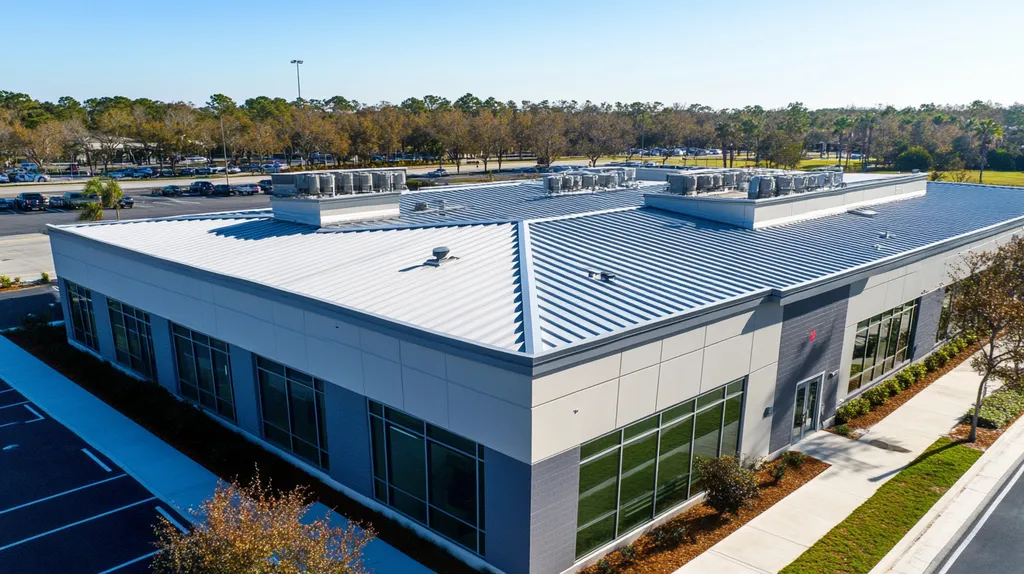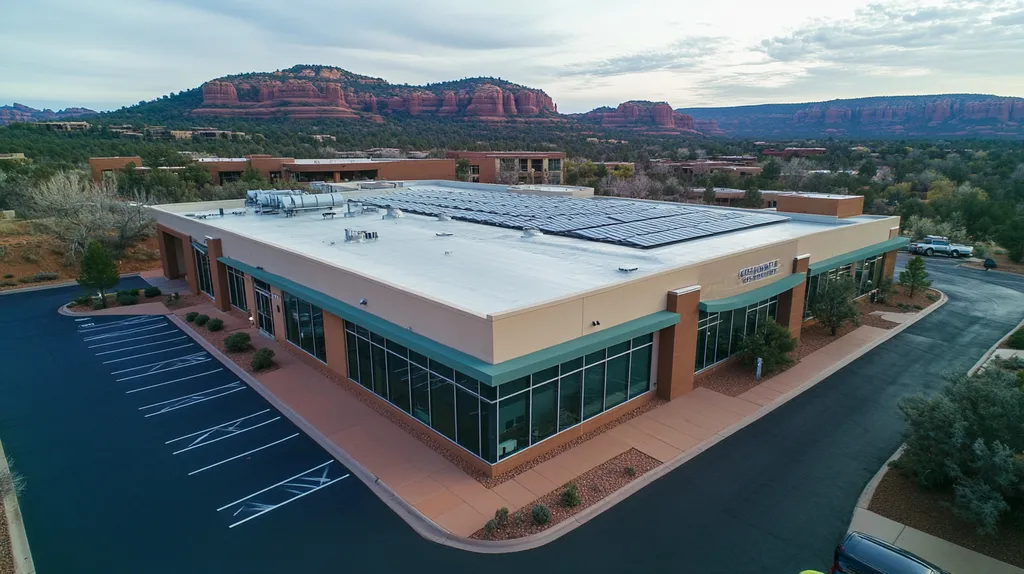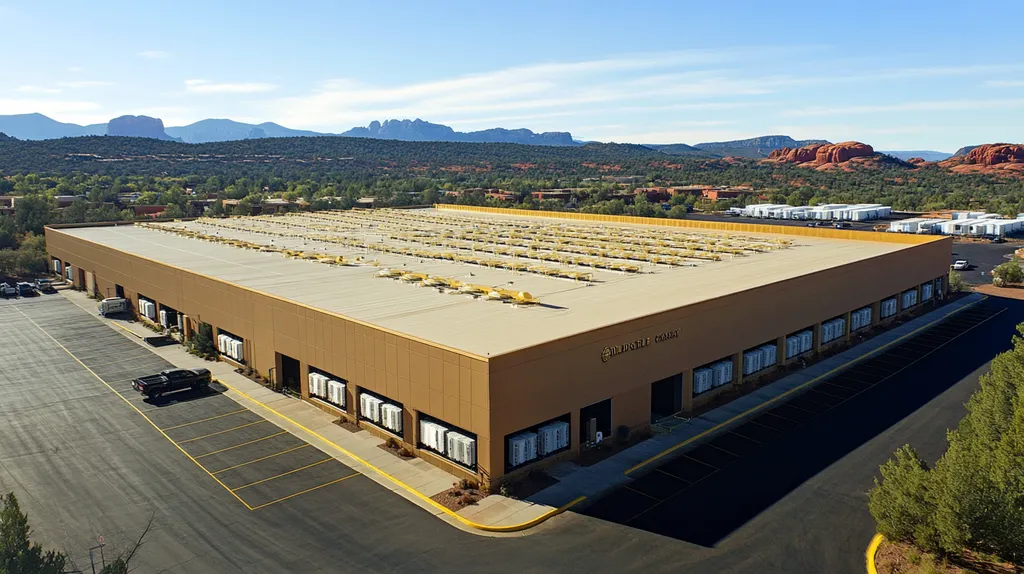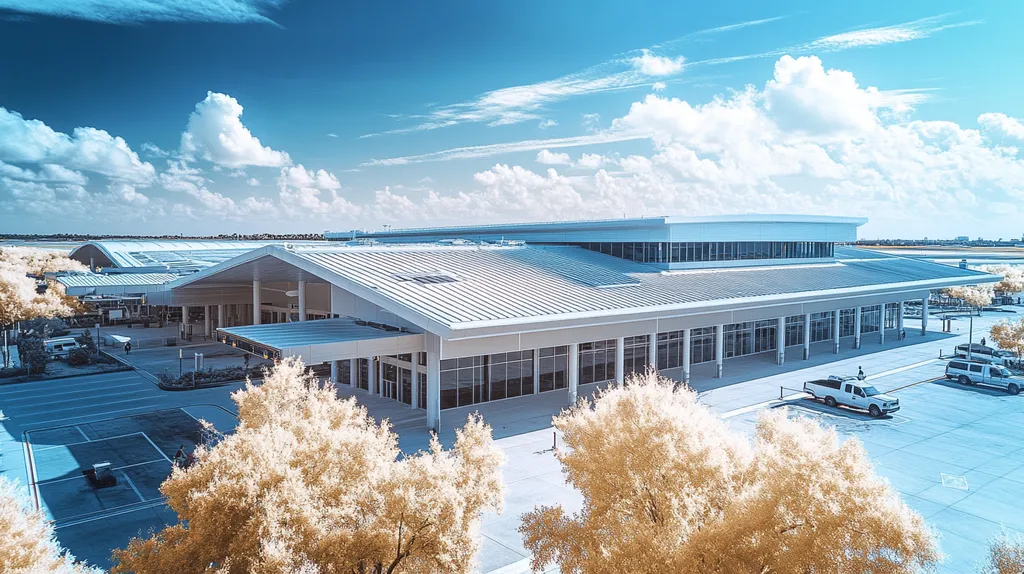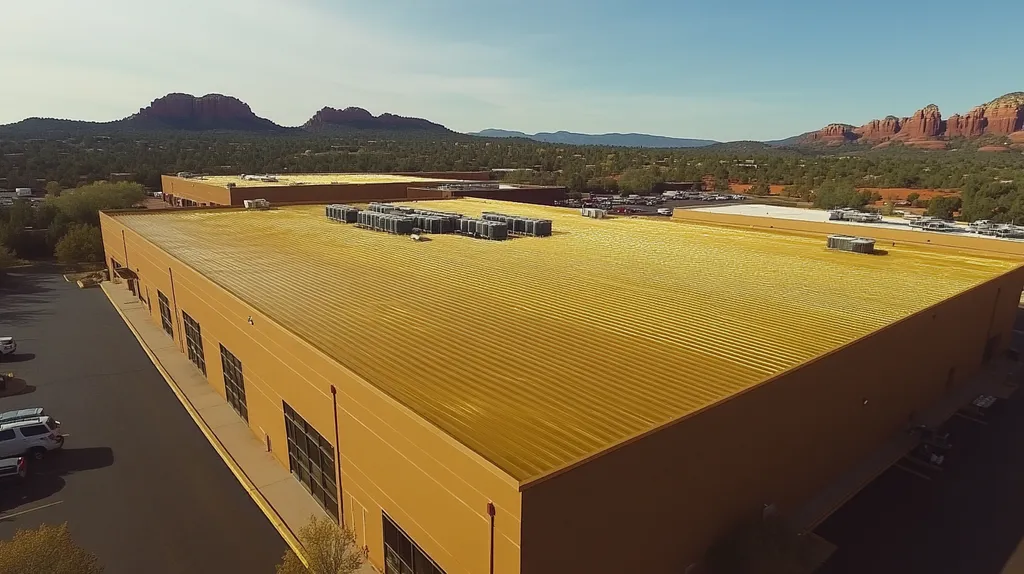Water damage from poor roof drainage costs commercial building owners over $3.7 billion annually, with most cases being entirely preventable. Even minor drainage issues can add dangerous structural loads exceeding 60 pounds per square foot during heavy rainfall.
As extreme weather events become more common, proper commercial roof drainage has evolved from a basic maintenance concern into a critical risk management priority.
This comprehensive guide separates common drainage myths from evidence-based solutions, helping property managers protect their investments through proper water management strategies.
SECTION 1: COMMON MISCONCEPTIONS
When it comes to commercial roofing, misinformation about drainage systems can lead to catastrophic failures and expensive repairs. Every year, thousands of building owners face premature roof replacement due to preventable water damage. Water accumulation on commercial roofs can add up to 60 pounds of weight per cubic foot, creating dangerous structural loads that threaten building integrity and occupant safety.
Flat Roofs Are Truly Level Without Slope
Despite their name, flat roofs should never be completely level. Professional roofing design requires a minimum slope to facilitate proper water drainage and prevent pooling.
Building codes typically mandate a minimum slope of ¼ inch per foot for commercial roofs. This subtle incline, while nearly invisible to the naked eye, plays a crucial role in directing water toward drains and preventing accumulation.
Modern roofing materials are engineered to work with specific slope requirements. Installing a truly level roof not only violates these specifications but can void manufacturer warranties and insurance coverage.
Even minor deviations from recommended slopes can create low spots where water collects. These areas become prime locations for material degradation and eventual leaks.
Drainage Systems Are Optional for Flat Roofs
Many building owners view comprehensive drainage systems as an unnecessary expense rather than an essential component of roof design. This dangerous misconception often leads to costly water damage and structural issues.
A single inch of rainfall on a 10,000-square-foot roof produces over 6,000 gallons of water. Without proper drainage pathways, this massive volume has nowhere to go except through vulnerable roof components.
Internal drains, scuppers, and gutters work together as an integrated system to channel water safely away from the roof surface. Each component serves a specific purpose in protecting the building envelope.
Emergency overflow systems provide crucial backup protection during heavy storms when primary drains may become overwhelmed. Skipping these redundant systems leaves buildings vulnerable to catastrophic failures.
Ponding Water Does Not Cause Structural Damage
The belief that standing water will simply evaporate without consequences ignores the devastating effects of prolonged ponding. Water accumulation accelerates the deterioration of roofing materials and compromises structural integrity.
Ponding creates a cyclic freeze-thaw pattern in cold climates that can crack and separate roofing components. This damage often goes unnoticed until leaks appear, requiring extensive repairs.
Standing water attracts biological growth like algae and vegetation that can penetrate protective roof layers. Their root systems create channels for water infiltration while adding weight to already stressed areas.
The combination of material degradation and increased load can cause deck deflection, creating even larger ponding areas. This self-reinforcing cycle eventually leads to system failure if left unchecked.
SECTION 2: PRACTICAL IMPLICATIONS
The consequences of inadequate commercial roof drainage extend far beyond occasional leaks. Industry data shows that water-related issues account for over 70% of premature roof failures, with repair costs often exceeding $10 per square foot. Without proper drainage, a 20,000-square-foot commercial roof can collect up to 12,000 gallons of water during a single one-inch rainfall event, creating dangerous structural loads and accelerating material deterioration.
Effects of Poor Drainage on Roof Integrity
Inadequate drainage creates a cascade of structural problems that compound over time. The weight of accumulated water causes deck deflection, creating new low spots that collect even more water and accelerate the deterioration cycle.
These low spots become epicenters for material failure, as constant water exposure breaks down protective coatings and compromises waterproofing layers. Even small amounts of standing water can triple the rate of membrane aging.
The added weight stress from ponding water can exceed design loads by 300%, leading to deck sagging and potential structural failure. This is particularly dangerous during freeze-thaw cycles when ice formation creates additional expansion forces.
Advanced drainage solutions like siphonic systems can move water 100 times faster than traditional gravity drainage, preventing dangerous accumulation while allowing more flexible building design. (source: Waterproof Magazine)
Impact of Standing Water on Roofing Materials
Standing water accelerates the degradation of roofing materials through multiple mechanisms. UV rays magnified by water pools cause rapid breakdown of membrane surfaces, while constant moisture promotes microbial growth that feeds on organic components.
Chemical interactions between standing water and roofing adhesives can weaken seams and flashings. These weakened areas become prime locations for leaks and material separation.
Thermal cycling causes repeated expansion and contraction, particularly damaging where water has penetrated between layers. This movement creates gaps that allow more water infiltration, perpetuating the damage cycle.
The combination of physical, chemical, and biological degradation can reduce a roof’s expected lifespan by 50% or more when drainage issues persist.
Maintenance Requirements for Effective Drainage
Regular drainage system maintenance requires a systematic approach focused on prevention. Monthly inspections should examine drain covers, strainers, and surrounding membrane areas for damage or deterioration.
Debris removal must extend beyond visible surface cleaning to include internal drain lines and leader pipes. Blocked internal components can cause hidden backups that manifest only during major rain events.
Seasonal maintenance should address specific challenges like spring pollen accumulation and fall leaf debris. Winter preparations must include heat tape maintenance for drain areas in cold climates.
Documentation of all drainage maintenance activities creates a valuable record for warranty compliance and helps identify developing problems before they become critical.
SECTION 3: COST OF MISINFORMATION
Poor drainage systems on commercial roofs create a devastating financial domino effect that extends far beyond simple repairs. Industry data reveals that water-related damage accounts for over $3.7 billion in annual commercial property losses. What begins as minor ponding can escalate into catastrophic structural failures, putting both assets and operations at risk. Understanding these financial implications is crucial for making informed decisions about roof drainage systems.
Financial Risks from Neglecting Drainage Design
Efficient roof drainage systems are imperative for preventing costly water damage by redirecting rainwater and melted snow away from the roof and building foundation. When water is not properly diverted, it can seep into the building, causing extensive damage to interior walls, ceilings, and electrical systems. (source: Scates Corporation)
Insurance carriers increasingly scrutinize drainage system maintenance records when processing claims. Buildings with documented drainage issues often face higher premiums or coverage restrictions, creating additional financial strain.
The impact on property valuation can be severe, with poorly maintained drainage systems reducing building value by up to 15%. This depreciation affects both resale potential and refinancing options.
Deferred maintenance compounds these issues, as minor drainage problems evolve into major structural concerns requiring extensive capital investment.
Repair and Replacement Costs from Water Damage
Water infiltration from inadequate drainage typically requires immediate intervention, often at premium rates. Emergency repairs can cost 300% more than scheduled maintenance work.
The scope of water damage frequently extends beyond visible areas, requiring extensive investigation and remediation. Hidden moisture can compromise insulation, corrode metal components, and create conditions for mold growth.
When drainage issues persist, building owners face accelerated deterioration of roofing materials. This often leads to premature replacement, cutting expected roof lifespan by 40% or more.
Secondary damage to inventory, equipment, and finished spaces can dwarf the cost of initial repairs. A single major water intrusion event can result in losses exceeding $100,000.
Productivity Losses Due to Building Downtime
Water damage repairs frequently require partial or complete building evacuation, disrupting normal operations. Even minor leaks can render significant portions of a facility unusable.
The average water-related shutdown lasts 72 hours, but extensive damage can extend downtime to weeks or months. Each day of closure represents lost revenue and missed opportunities.
Relocating operations during repairs creates additional expenses and logistical challenges. Temporary facilities, equipment moves, and productivity losses can double the true cost of water damage.
Customer relationships suffer when service interruptions occur, potentially leading to permanent business loss. Studies show that 40% of businesses never fully recover from extended facility closures.
Employee health concerns from moisture-related issues can trigger workplace safety investigations and potential liability claims. These secondary effects further compound the financial impact of poor drainage.
SECTION 4: REALITY CHECK
Water management on commercial roofs represents a critical engineering challenge that demands precise solutions. Every year, thousands of buildings suffer preventable damage due to inadequate drainage systems, with repair costs often exceeding millions of dollars. Modern commercial roofs must handle increasingly extreme weather events while protecting valuable assets below. Understanding and implementing proper drainage solutions has become essential for maintaining building integrity and operational continuity.
Importance of Positive Drainage and Roof Slope
Effective water management begins with proper roof slope design. Even minor deviations from recommended slopes can create areas of water accumulation that compromise roof integrity and accelerate material deterioration.
Proper roof slope design enables the rapid movement of water toward collection points. Industry standards typically require a minimum slope of 1/4 inch per foot, though specific requirements may vary based on roof size and local climate conditions.
Tapered insulation systems offer a practical solution for creating positive drainage on existing roofs. These systems can correct structural deficiencies while providing additional thermal benefits.
Regular slope assessment helps identify areas where settling or structural movement may have created low spots. Early detection of these issues allows for targeted corrections before water damage occurs.
Role of Multiple Drains and Overflow Systems
Comprehensive drainage design requires strategic placement of multiple drain points to ensure efficient water removal. Each drain serves a specific coverage area, with overlap providing redundancy during heavy rainfall.
Proper roof design requires a slight slope to encourage drainage, coupled with efficient systems including gutters, downspouts, and roof drains. Regular cleaning and inspection prevent clogs that can compromise the entire system. (source: ASIRFG)
Emergency overflow systems provide crucial backup protection during extreme weather events. These secondary drainage components prevent catastrophic failures when primary systems become overwhelmed.
The integration of multiple drainage pathways creates a resilient system capable of handling varying water volumes. This redundancy proves especially valuable during sustained rainfall or rapid snow melt.
Advances in Drainage Technology for Large Roofs
Modern drainage solutions incorporate sophisticated monitoring systems that track water levels and flow rates. These technologies enable proactive maintenance by identifying potential issues before they become critical.
Smart drainage systems now feature automated alerts that notify facility managers when water accumulation exceeds acceptable thresholds. This real-time monitoring helps prevent the devastating effects of prolonged ponding.
Advanced materials and design techniques have improved drain capacity and reliability. High-flow systems can now move significantly more water while requiring less maintenance than traditional designs.
Emerging technologies in prefabricated drainage components reduce installation complexity while improving performance. These standardized solutions offer consistent quality and simplified maintenance procedures.
SECTION 5: EVIDENCE-BASED ALTERNATIVES
Commercial roof drainage has evolved dramatically in recent years, yet many buildings still rely on outdated systems that leave them vulnerable to water damage. Research shows that upgrading to modern drainage solutions can reduce maintenance costs by up to 60% while extending roof lifespan by 15-20 years. For large commercial facilities, the choice between traditional and advanced drainage systems can mean the difference between reliable protection and catastrophic failure.
Gravity vs. Siphonic Drainage Systems Explained
Traditional gravity drainage systems remain effective for smaller commercial roofs, relying on slope and gravity to channel water toward collection points. However, these systems often struggle during heavy rainfall events, leading to potential ponding and structural stress.
Siphonic drainage systems represent a significant advancement in water management technology, using negative pressure to rapidly evacuate water from roof surfaces. These systems can move water 100 times faster than traditional gravity drainage, preventing dangerous accumulation while allowing more flexible building design. (source: Waterproof Magazine)
Modern siphonic systems require fewer roof penetrations and smaller pipe diameters, reducing installation costs and potential leak points. This efficiency translates to significant savings in both materials and labor.
The selection between gravity and siphonic systems depends largely on roof size, local rainfall intensity, and building configuration. Larger facilities typically benefit most from siphonic systems’ superior performance.
Integrating Scuppers, Gutters, and Internal Drains
Effective drainage requires a coordinated system of multiple components working together. Primary internal drains serve as the first line of defense, positioned at strategic low points to maximize water collection.
Scuppers provide crucial emergency overflow protection, preventing catastrophic accumulation during extreme weather events. Their placement must account for both normal and emergency drainage patterns.
Modern gutter systems incorporate enhanced profiles and materials that resist clogging while handling higher water volumes. These improvements significantly reduce maintenance requirements and system failures.
Integration of these components must follow precise engineering calculations to ensure proper water flow and prevent system overload. Each element serves as a backup for the others, creating redundancy for critical protection.
Selecting Durable Roofing Materials for Water Resistance
Material selection directly impacts drainage system effectiveness. Modern single-ply membranes offer superior resistance to standing water while maintaining flexibility for proper drainage slopes.
High-performance coating systems can enhance existing roof surfaces, improving water resistance without the need for complete replacement. These coatings also protect against UV damage that can compromise drainage integrity.
Advanced membrane welding techniques create stronger seams that resist water infiltration even under prolonged exposure. This technology significantly reduces the risk of leaks at critical junction points.
The integration of proper underlayment and insulation materials supports effective drainage while providing additional protection against water damage. These layers work together to maintain slope and prevent deck deterioration.
SECTION 6: TEST AND VERIFY
Undetected drainage issues cost commercial property owners millions annually in preventable damage. Studies show that 85% of premature roof failures stem from water-related problems that proper testing could have identified early. Without regular verification of drainage system performance, minor issues can escalate into catastrophic failures that threaten both building integrity and business operations.
Routine Inspections for Ponding and Drain Function
Every commercial roof requires systematic inspection protocols to identify potential drainage issues before they escalate. Monthly visual assessments should focus on common problem areas like drain covers, scuppers, and known low spots where water tends to collect.
Professional inspections must occur after every major storm event and at least quarterly to document ponding patterns. These evaluations should measure standing water depth and duration, as prolonged ponding accelerates material degradation.
Drain functionality testing involves measuring flow rates and checking for debris accumulation that could restrict water movement. Even partial blockages can reduce drainage capacity by up to 70%, creating dangerous load conditions during heavy rainfall.
Documentation through photos and detailed reports creates a valuable historical record for tracking drainage performance over time. This data helps identify developing problems and validates warranty claims when issues arise.
Methods to Verify Drainage Efficiency on Site
Flow testing using calibrated water volumes provides quantifiable data about drainage system performance. These tests should simulate various rainfall intensities to verify system capacity under different conditions.
Dye testing helps trace water movement patterns and identify areas where flow is restricted or redirected improperly. This method reveals hidden drainage paths that may contribute to ponding issues.
Electronic water level monitors installed at strategic points track actual performance during natural rainfall events. These devices provide continuous data about drainage response times and system efficiency.
Regular pressure testing of internal drain lines ensures they maintain proper flow capacity. Reduced pressure readings often indicate developing clogs or structural issues that require immediate attention.
Using Infrared and Moisture Sensors to Detect Issues
Modern infrared scanning technology can detect moisture trapped within roofing systems before visible damage occurs. These scans should be conducted bi-annually to create thermal maps identifying potential problem areas.
Permanently installed moisture sensors provide continuous monitoring of conditions within the roofing assembly. Real-time alerts notify facility managers when moisture levels exceed acceptable thresholds.
Advanced drone-mounted sensors can now create detailed topographic maps showing subtle variations in roof slope. This technology helps identify areas where settling or structural movement may be compromising drainage patterns.
Integration of these technologies with building management systems enables automated response protocols. When sensors detect developing issues, maintenance teams can respond quickly to prevent water damage.
The Bottom Line
With commercial roof drainage failures causing over $3.7 billion in annual losses, building owners can no longer afford to ignore proper water management systems.
Modern drainage solutions, from siphonic systems to smart monitoring technology, now provide cost-effective protection against even extreme weather events.
The evidence is clear: buildings with properly designed and maintained drainage systems experience 60% lower maintenance costs and up to 20 years of additional roof life.
Regular testing and verification using advanced diagnostic tools can identify potential issues before they escalate into costly repairs.
As weather patterns become more extreme, investing in comprehensive drainage solutions isn’t just about protecting buildings – it’s about ensuring business continuity and asset preservation for decades to come.
FREQUENTLY ASKED QUESTIONS
Q. Are flat roofs really level or do they need slope?
A. Flat roofs need a slight slope to ensure proper drainage. Without this slope, water can pool in low spots, leading to deterioration and leaks. Building codes usually require a minimum slope to direct water toward drains effectively.
Q. What are the consequences of poor drainage on commercial roofs?
A. Poor drainage can lead to excessive weight on roofs from standing water. This additional stress can cause deck deflection and ultimately compromise structural integrity, which may result in costly repairs and an increased risk of water-related failures.
Q. How much can misinformation about drainage cost for roofs?
A. Misinformation can lead to improper drainage design, resulting in severe water damage and costly repairs. This can significantly elevate repair costs, building insurance premiums, and even reduce property value due to unresolved drainage issues.
Q. Why is positive drainage required for commercial roofs?
A. Positive drainage is crucial for removing water efficiently and preventing pooling. Every component from slopes to drains works together to direct rainwater away from the roof, reducing the risk of structural damage and extending roof lifespan.
Q. What is the advantage of modern drainage systems?
A. Modern drainage systems can handle larger volumes of water while requiring less maintenance. These systems help reduce the risk of standing water, prolong the roof’s lifespan, and provide better protection against water infiltration and related damage.
Q. How can roof drainage systems be verified?
A. Regular inspections should include monitoring drain function, testing flow rates, and checking for debris. Advanced methods like dye testing and infrared scanning can help identify hidden issues, ensuring that drainage systems work as intended before damage occurs.
Q. What types of roofing materials improve drainage?
A. Selecting durable roofing materials, such as single-ply membranes, enhances water resistance. High-performance coating systems can also improve surfaces, ensuring effective drainage while prolonging the roof’s durability against environmental stressors like UV damage and moisture.

